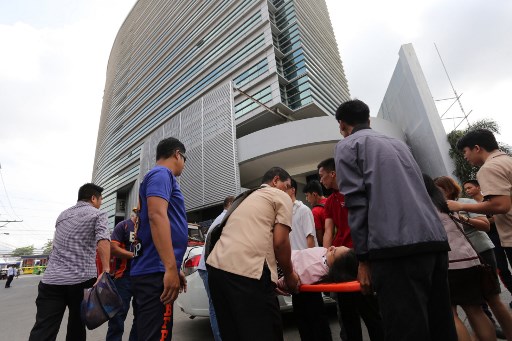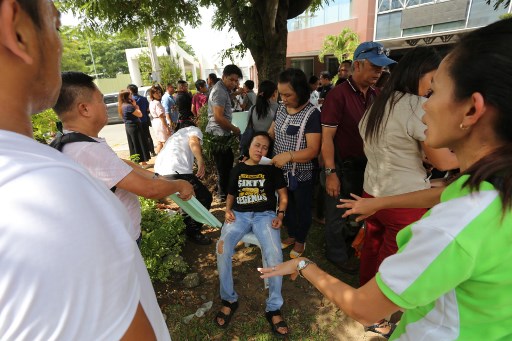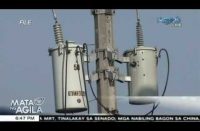(Eagle News) – At least six persons were killed after a 6.6 magnitude earthquake that hit Tulunan, Cotabato around 9 a.m. Tuesday morning, Oct. 29, which was also felt in other parts of Mindanao.
One fatality was identified by the National Disaster Risk Reduction and Management Council (NDRRMC) as Nestor Narciso, 66, from Koronadal City, while the other fatality was a boy who was fleeing his schoolroom during the quake.
Agence France Presse said that the teenage boy was crushed by a falling wall as he tried to escape his school in Magsaysay, according to the town spokesperson.
Though other students were injured in “stampede” to escape the building, they survived, an AFP report said.
The other two fatalities, later reported, were a father and his child in Arakan, Cotabato.
Another pregnant woman was killed in Barangay Banayal, Tulunan, Cotabato. The sixth fatality was a 36-year old man from Digos, Davao del Sur identified as Jeremie Sarno.
The quake has injured a still undetermined number of people, but the South Cotabato provincial government has said that there were at least 70 persons injured.
In Davao City, many were also reported injured. People ran out of buildings as the strong tremor was felt at intensity 6. Residents especially those in tall buildings panicked as they had not even yet recovered from a previous strong quake that hit the region, specifically less than two weeks ago.

The epicenter of Tuesday morning’s quake was located 25 kilometers southeast of Tulunan Cotabato. It struck at 9:04 a.m., Oct. 29, according to the Philippine Institute of Volcanology and Seismology (PHIVOLCS).
The quake was quite shallow with a depth of focus of only 7 kilometers, and was felt at intensity 7 in Tulunan and Makilala in Cotabato; Kidapawan City; and Malungon in Sarangani.
It was also felt at intensity 6 in Davao City, Koronadal City, and Cagayan de Oro City, while the towns of Tampakan, Surallah and Tupi in South Cotabato, and Alabel in Sarangani felt it at intensity 5.

The tremor was also felt at Intensity 3 in Sergio Osmeña Sr., Zamboanga del Norte; Zamboanga City; Dipolog City; Molave, Zamboanga del Norte; and Talakag, Bukidnon
Below are the instrumental intensities recorded by Phivolcs:
Intensity VII – Kidapawan City; Malungon, Sarangani
Intensity V – Alabel, Sarangani; Tupi, South Cotabato
Intensity IV – Gingoog City, Misamis Oriental; General Santos City
Intensity II – Zamboanga City
Intensity I- Dipolog City; Bislig City; Palo, Leyte
Mindanao was still reeling from a previous deadly tremor.
Terrified locals ran into the streets after the shallow quake, which hit the island of Mindanao as schools and offices opened for the day.
-One minute of shaking-
The shaking lasted up to a minute in some areas, damaging homes, multi-storey buildings and classrooms in a region where hundreds are still displaced by a quake that killed at least five earlier this month.
The Philippines suffers regular tremors as part of the Pacific “Ring of Fire”, an arc of intense seismic activity that stretches from Japan through Southeast Asia and across the Pacific basin.
Locals were awed by the power of the quake, which was shallow and thus potentially more destructive.
“Buildings were not just moving, they were swaying,” Gadi Sorilla, a doctor at a hospital in Tulunan, a town about 25 kilometres (15 miles) from the epicentre told AFP.
“I asked God for help,” he said, adding the hospital had quickly received about 10 patients, some with head injuries.
Local disaster authorities had received a report of a missing person, but were still working to confirm it.
Tulunan’s mayor Reuel Limbungan said the local municipal hall had been heavily damaged and authorities had received “lots of reports of injuries”.
Rescue teams have begun fanning out to assess the damage to the region, where electricity and phone services were knocked out by the power of the quake.
“It is possible to have other aftershocks which could add to the damage. People should stay outside for now,” said Renato Solidum, head of PHIVOLCS.
The US Geological Survey said the initial quake was followed by a number of smaller shakes, including one of 5.8 magnitude.
The continuing tremors were causing anxiety on the ground, with people refusing to go back inside buildings for fear of being caught in any resulting collapse.
– Hundreds still displaced –
Schools across the area have been shuttered as a precaution.
The area is still suffering the effects of a 6.4-magnitude quake that hit less than two weeks ago, killing at least five people and damaging dozens of buildings.
Residents fled homes across the Mindanao region and a mall caught fire in the city of General Santos shortly after the quake struck on October 16.
“We still have 570 individuals in evacuation centers (from the previous quake) and with this quake, we are expecting more evacuees.
One of the deadliest quakes to hit the Philippines recently was in April, provoking the collapse of a building in Pampanga, which is near the Philippine capital of Manila.
At least 16 people were killed when the building pancaked in the worst-hit Pampanga province.
High-rise structures in the capital swayed after the April quake, leaving some with large cracks in their walls.
Thousands of travelers were stranded after aviation authorities shut down the secondary Clark Airport, which is located on the site of the former US military installation that lies about an hour’s drive north of the capital.
(with a report from Agence France-Presse)







